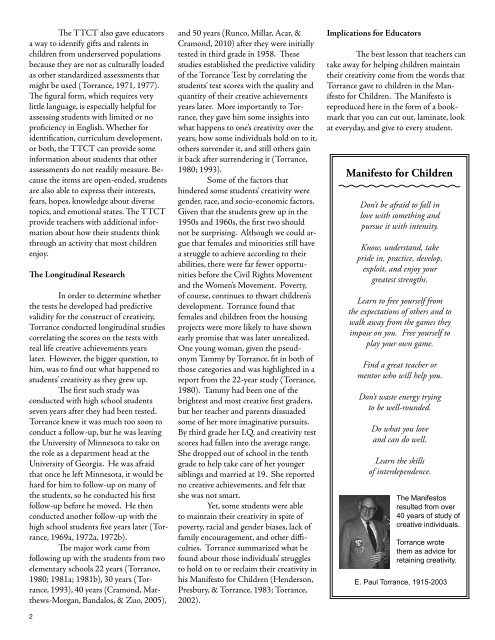Torrance Journal for Applied Creativity
TorranceJournal_V1
TorranceJournal_V1
Create successful ePaper yourself
Turn your PDF publications into a flip-book with our unique Google optimized e-Paper software.
The TTCT also gave educators<br />
a way to identify gifts and talents in<br />
children from underserved populations<br />
because they are not as culturally loaded<br />
as other standardized assessments that<br />
might be used (<strong>Torrance</strong>, 1971, 1977).<br />
The figural <strong>for</strong>m, which requires very<br />
little language, is especially helpful <strong>for</strong><br />
assessing students with limited or no<br />
proficiency in English. Whether <strong>for</strong><br />
identification, curriculum development,<br />
or both, the TTCT can provide some<br />
in<strong>for</strong>mation about students that other<br />
assessments do not readily measure. Because<br />
the items are open-ended, students<br />
are also able to express their interests,<br />
fears, hopes, knowledge about diverse<br />
topics, and emotional states. The TTCT<br />
provide teachers with additional in<strong>for</strong>mation<br />
about how their students think<br />
through an activity that most children<br />
enjoy.<br />
The Longitudinal Research<br />
In order to determine whether<br />
the tests he developed had predictive<br />
validity <strong>for</strong> the construct of creativity,<br />
<strong>Torrance</strong> conducted longitudinal studies<br />
correlating the scores on the tests with<br />
real life creative achievements years<br />
later. However, the bigger question, to<br />
him, was to find out what happened to<br />
students’ creativity as they grew up.<br />
The first such study was<br />
conducted with high school students<br />
seven years after they had been tested.<br />
<strong>Torrance</strong> knew it was much too soon to<br />
conduct a follow-up, but he was leaving<br />
the University of Minnesota to take on<br />
the role as a department head at the<br />
University of Georgia. He was afraid<br />
that once he left Minnesota, it would be<br />
hard <strong>for</strong> him to follow-up on many of<br />
the students, so he conducted his first<br />
follow-up be<strong>for</strong>e he moved. He then<br />
conducted another follow-up with the<br />
high school students five years later (<strong>Torrance</strong>,<br />
1969a, 1972a, 1972b).<br />
The major work came from<br />
following up with the students from two<br />
elementary schools 22 years (<strong>Torrance</strong>,<br />
1980; 1981a; 1981b), 30 years (<strong>Torrance</strong>,<br />
1993), 40 years (Cramond, Matthews-Morgan,<br />
Bandalos, & Zuo, 2005),<br />
2<br />
and 50 years (Runco, Millar, Acar, &<br />
Cramond, 2010) after they were initially<br />
tested in third grade in 1958. These<br />
studies established the predictive validity<br />
of the <strong>Torrance</strong> Test by correlating the<br />
students’ test scores with the quality and<br />
quantity of their creative achievements<br />
years later. More importantly to <strong>Torrance</strong>,<br />
they gave him some insights into<br />
what happens to one’s creativity over the<br />
years, how some individuals hold on to it,<br />
others surrender it, and still others gain<br />
it back after surrendering it (<strong>Torrance</strong>,<br />
1980; 1993).<br />
Some of the factors that<br />
hindered some students’ creativity were<br />
gender, race, and socio-economic factors.<br />
Given that the students grew up in the<br />
1950s and 1960s, the first two should<br />
not be surprising. Although we could argue<br />
that females and minorities still have<br />
a struggle to achieve according to their<br />
abilities, there were far fewer opportunities<br />
be<strong>for</strong>e the Civil Rights Movement<br />
and the Women’s Movement. Poverty,<br />
of course, continues to thwart children’s<br />
development. <strong>Torrance</strong> found that<br />
females and children from the housing<br />
projects were more likely to have shown<br />
early promise that was later unrealized.<br />
One young woman, given the pseudonym<br />
Tammy by <strong>Torrance</strong>, fit in both of<br />
those categories and was highlighted in a<br />
report from the 22-year study (<strong>Torrance</strong>,<br />
1980). Tammy had been one of the<br />
brightest and most creative first graders,<br />
but her teacher and parents dissuaded<br />
some of her more imaginative pursuits.<br />
By third grade her I.Q. and creativity test<br />
scores had fallen into the average range.<br />
She dropped out of school in the tenth<br />
grade to help take care of her younger<br />
siblings and married at 19. She reported<br />
no creative achievements, and felt that<br />
she was not smart.<br />
Yet, some students were able<br />
to maintain their creativity in spite of<br />
poverty, racial and gender biases, lack of<br />
family encouragement, and other difficulties.<br />
<strong>Torrance</strong> summarized what he<br />
found about those individuals’ struggles<br />
to hold on to or reclaim their creativity in<br />
his Manifesto <strong>for</strong> Children (Henderson,<br />
Presbury, & <strong>Torrance</strong>, 1983; <strong>Torrance</strong>,<br />
2002).<br />
Implications <strong>for</strong> Educators<br />
The best lesson that teachers can<br />
take away <strong>for</strong> helping children maintain<br />
their creativity come from the words that<br />
<strong>Torrance</strong> gave to children in the Manifesto<br />
<strong>for</strong> Children. The Manifesto is<br />
reproduced here in the <strong>for</strong>m of a bookmark<br />
that you can cut out, laminate, look<br />
at everyday, and give to every student.<br />
Manifesto <strong>for</strong> Children<br />
Don’t be afraid to fall in<br />
love with something and<br />
pursue it with intensity.<br />
Know, understand, take<br />
pride in, practice, develop,<br />
exploit, and enjoy your<br />
greatest strengths.<br />
Learn to free yourself from<br />
the expectations of others and to<br />
walk away from the games they<br />
impose on you. Free yourself to<br />
play your own game.<br />
Find a great teacher or<br />
mentor who will help you.<br />
Don’t waste energy trying<br />
to be well-rounded.<br />
Do what you love<br />
and can do well.<br />
Learn the skills<br />
of interdependence.<br />
The Manifestos<br />
resulted from over<br />
40 years of study of<br />
creative individuals.<br />
<strong>Torrance</strong> wrote<br />
them as advice <strong>for</strong><br />
retaining creativity.<br />
E. Paul <strong>Torrance</strong>, 1915-2003


